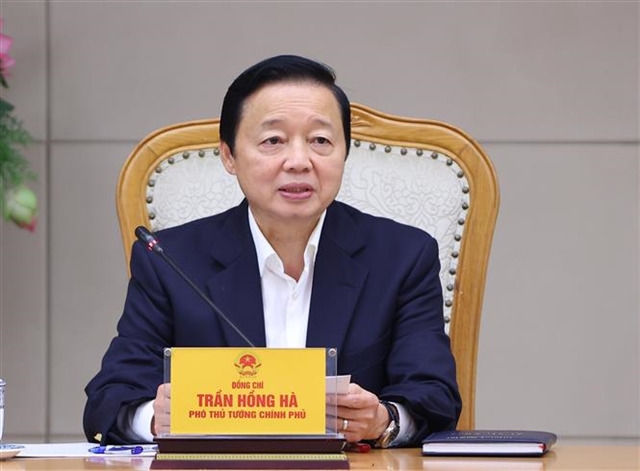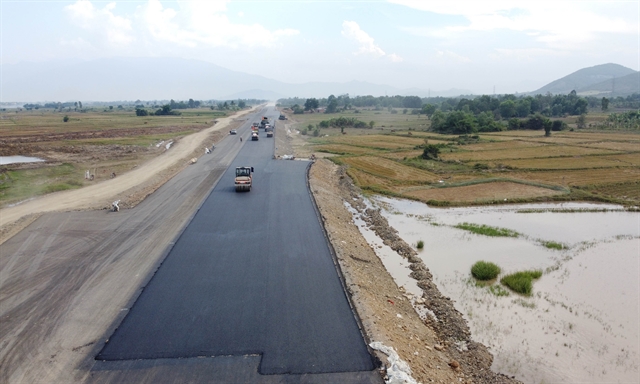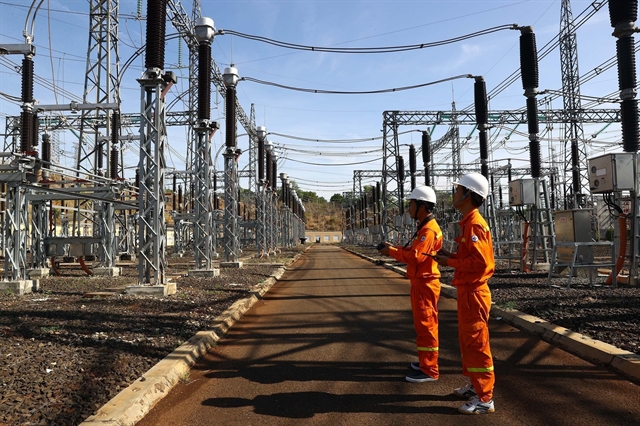 Politics & Law
Politics & Law

 |
| Some sections of the Khánh Hòa–Buôn Ma Thuột expressway have been paved. — VNA/VNS Photos |
HÀ NỘI — With the clock ticking on the race to complete 3,000km of expressways in 500 days, Việt Nam is pushing boundaries to meet its ambitious 2025 target.
This effort, rooted in a resolution from the 13th National Party Congress, seeks to establish synchronised and modern infrastructure as a key driver for rapid, sustainable socio-economic development.
These infrastructure goals align with the country's vision of achieving high middle-income status by 2030 and becoming a high-income, developed nation by 2045.
Unprecedented achievements
The progress in infrastructure over the past year reflects both urgency and innovation.
A notable project is the Quảng Bình–Hưng Yên 500kV transmission line, which was completed in just over six months, a significant achievement in a sector where such projects typically take three to four years.
This success resulted from decisive government leadership, mobilisation of the political system and strong public support, serving as a model for efficient, high-impact infrastructure development.
Equally transformative are the ongoing efforts to expand the nation’s transport network.
The North-South Expressway, alongside key projects like Khánh Hòa–Buôn Ma Thuột, Biên Hòa–Vũng Tàu and Châu Đốc–Cần Thơ–Sóc Trăng, has extended the total expressway length to 2,021km.
These highways are vital for improving regional connectivity and enhancing Việt Nam’s economic competitiveness.
In aviation, the Long Thành International Airport, set to be a major Southeast Asian hub, and Tân Sơn Nhất’s Terminal 3 are progressing.
Urban railway development has also gained momentum, with the operation of the Nhổn–Hà Nội Station in the northern capital city and Bến Thành–Suối Tiên metro lines in the southern metropolis.
Preparations for international rail links with China further highlight the country’s commitment to regional integration.
Energy infrastructure is progressing rapidly as well, with projects such as the Nhơn Trạch 3 and 4 power plants and the Block B–Ô Môn gas-power chain making substantial headway.
Institutional reforms, including the introduction of the Data Law and amendments to the Electricity Law, are enabling advancements in digital and renewable energy infrastructure.
Behind these achievements lies a steadfast commitment to overcoming challenges.
Prime Minister Phạm Minh Chính has urged relentless efforts to meet ambitious targets.
The Government has successfully mobilised resources from both central and local budgets, leveraging increased revenue and cost-saving measures to double the length of expressways in just three years, an achievement unmatched in the previous two decades.
However, challenges remain.
General Secretary Tô Lâm has pointed out inefficiencies in planning and investment, citing fragmented airport and seaport development, imbalanced energy infrastructure and inadequate urban connectivity. Delays in digital infrastructure remain a major obstacle.
To address these, the Government is refining planning processes, encouraging inter-agency coordination and implementing special mechanisms under the revised Public Investment Law to streamline decision-making procedures and reduce administrative bottlenecks.
 |
| Workers remain on duty during the National Day holiday (September 2). |
Goals for 2025
Prime Minister Chính has outlined key priorities for 2025, including achieving 8 per cent GDP growth and completing at least 3,000km of expressways, with Long Thành International Airport slated to become operational. These efforts are central to the 2021–30 development plan.
The Government is focusing on major infrastructure projects, such as expressway links to airports and seaports, the high-speed North-South Railway, rail connections to China and urban railways in Hà Nội and HCM City.
Port projects like Lạch Huyện and Liên Chiểu are advancing, and Cần Giờ Seaport is in the investment preparation phase.
By 2025, Việt Nam aims to complete 3,000km of expressways and 1,000km of coastal highways, limiting public investment projects to no more than 3,000 to prevent fragmentation.
"Our policy is to create infrastructure breakthroughs through strategic projects that transform the nation," said PM Chính.
The PM has stressed the importance of removing obstacles in developing transport, digital and energy infrastructure.
Investments in key projects are seen as growth drivers.
Between 2000 and 2021, Việt Nam built just 1,000km of expressways, but this has doubled in the past three years. This acceleration is credited to effective mobilisation of central and local budgets, surplus revenue and focusing resources on transformative projects.
Effective implementation hinges on refining institutions, mobilising resources, training skilled workers and improving governance.
The revised Public Investment Law aims to decentralise authority, streamline procedures and empower local decision-making.
According to Minister of Planning and Investment Nguyễn Chí Dũng, this law reduces delays, enhances transparency and boosts project completion rates, providing a solid legal framework for future development.
Land clearance has been identified as a critical issue for infrastructure projects.
Deputy Director Nguyễn Thế Minh of the Transport Infrastructure Investment Management Department noted that complex land ownership issues, compensation disputes, delays in constructing resettlement areas and technical challenges in relocating power lines have all hindered progress. Many localities are still struggling to meet deadlines due to these issues.
Another significant concern is the shortage of construction materials, particularly sand in the Mekong Delta.
Localities have maximised output from quarries, but extraction capacities remain insufficient. The special mechanisms for mining licences have led to confusion, adding to delays. With several projects moving forward at once, the strain on resources has increased.
The Ministry of Transport has prioritised decisive interventions.
For site clearance, the ministry has collaborated with the Prime Minister to issue directives and mobilise political support at all levels. Provinces are urged to resolve compensation disputes and finalise resettlement plans promptly.
To address material shortages, the ministry has worked with the Ministry of Natural Resources and Environment to allocate sand quotas and streamline licensing procedures for quarries. It is also exploring alternative materials, such as marine sand, to reduce dependency on river sand.
For delayed projects, the ministry has called for revised timelines from investors and contractors, focusing on critical tasks causing delays.
Contractors are encouraged to adopt technical solutions and operate round-the-clock shifts to accelerate progress. Coordination among contractors is also being promoted to share resources efficiently.
Despite challenges, some projects are progressing faster than expected.
Notably, segments of the North-South Expressway (2021–2025) are set to finish months ahead of schedule.
Projects originally slated for completion in 2026, such as Khánh Hòa–Buôn Ma Thuột and An Hữu–Cao Lãnh, are now being fast-tracked for completion by 2025.
Unlocking growth potential
 |
| Workers inspect heat emissions at the 500kV Pleiku 2 substation. |
The expansion of critical infrastructure is unlocking new opportunities for Việt Nam’s socio-economic development.
With a projected 8–9 per cent economic growth by 2025, the country faces a sharp rise in electricity demand, necessitating an annual 11 per cent growth in supply, according to the Ministry of Industry and Trade.
Minister Nguyễn Hồng Diên outlined the primary goal of the 8th National Power Development Plan (PDP8) for 2021–2030, which aims to ensure a stable electricity supply to support economic growth.
The plan highlights the need for diversified and sustainable energy sources to reduce dependency on imported fuels and strengthen energy security.
However, challenges remain, including delays in key power projects, particularly gas- and coal-fired plants, which could lead to capacity shortages, especially during dry seasons.
The PDP8 has approved 23 gas-fired power projects, but only one is operational, with many still in development.
Unless bottlenecks in LNG projects are resolved, significant supply shortages are expected between 2026 and 2030.
Coal power projects face delays, with five major plants stalled due to financing and regulatory issues. Hydropower expansion is limited, and renewable energy, particularly wind power, is struggling to meet targets.
Vietnam Electricity (EVN) has initiated over 80 projects and completed 100 electricity grid upgrades, including the 500kV Quảng Trạch–Phố Nối transmission line, which strengthens energy security in northern Việt Nam.
This project was completed in just six months, a notable achievement.
To meet the growing demand, the Government is taking decisive action. PM Chính has instructed agencies to secure sufficient fuel for power generation and expedite electricity imports from Laos and China.
Key transmission lines must be completed by the end of 2024 to ensure a stable supply.
These efforts, alongside expanded energy infrastructure and a commitment to resolving project delays, aim to secure Việt Nam’s energy supply and support its economic growth goals. — VNS